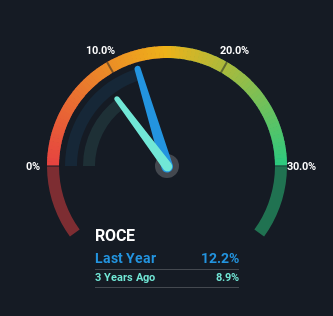The Returns On Capital At Sarveshwar Foods (NSE:SARVESHWAR) Don't Inspire Confidence

If you're not sure where to start when looking for the next multi-bagger, there are a few key trends you should keep an eye out for. Amongst other things, we'll want to see two things; firstly, a growing return on capital employed (ROCE) and secondly, an expansion in the company's amount of capital employed. Basically this means that a company has profitable initiatives that it can continue to reinvest in, which is a trait of a compounding machine. In light of that, when we looked at Sarveshwar Foods (NSE:SARVESHWAR) and its ROCE trend, we weren't exactly thrilled.
Understanding Return On Capital Employed (ROCE)
If you haven't worked with ROCE before, it measures the 'return' (pre-tax profit) a company generates from capital employed in its business. The formula for this calculation on Sarveshwar Foods is:
Return on Capital Employed = Earnings Before Interest and Tax (EBIT) ÷ (Total Assets - Current Liabilities)
0.12 = ₹412m ÷ (₹7.1b - ₹3.8b) (Based on the trailing twelve months to September 2023).
Therefore, Sarveshwar Foods has an ROCE of 12%. That's a relatively normal return on capital, and it's around the 14% generated by the Food industry.
View our latest analysis for Sarveshwar Foods

Historical performance is a great place to start when researching a stock so above you can see the gauge for Sarveshwar Foods' ROCE against it's prior returns. If you're interested in investigating Sarveshwar Foods' past further, check out this free graph of past earnings, revenue and cash flow.
What The Trend Of ROCE Can Tell Us
We weren't thrilled with the trend because Sarveshwar Foods' ROCE has reduced by 49% over the last five years, while the business employed 129% more capital. However, some of the increase in capital employed could be attributed to the recent capital raising that's been completed prior to their latest reporting period, so keep that in mind when looking at the ROCE decrease. Sarveshwar Foods probably hasn't received a full year of earnings yet from the new funds it raised, so these figures should be taken with a grain of salt.
On a related note, Sarveshwar Foods has decreased its current liabilities to 53% of total assets. That could partly explain why the ROCE has dropped. Effectively this means their suppliers or short-term creditors are funding less of the business, which reduces some elements of risk. Some would claim this reduces the business' efficiency at generating ROCE since it is now funding more of the operations with its own money. Keep in mind 53% is still pretty high, so those risks are still somewhat prevalent.
What We Can Learn From Sarveshwar Foods' ROCE
Bringing it all together, while we're somewhat encouraged by Sarveshwar Foods' reinvestment in its own business, we're aware that returns are shrinking. Yet to long term shareholders the stock has gifted them an incredible 1,047% return in the last five years, so the market appears to be rosy about its future. Ultimately, if the underlying trends persist, we wouldn't hold our breath on it being a multi-bagger going forward.
One final note, you should learn about the 4 warning signs we've spotted with Sarveshwar Foods (including 2 which make us uncomfortable) .
If you want to search for solid companies with great earnings, check out this free list of companies with good balance sheets and impressive returns on equity.
New: Manage All Your Stock Portfolios in One Place
We've created the ultimate portfolio companion for stock investors, and it's free.
• Connect an unlimited number of Portfolios and see your total in one currency
• Be alerted to new Warning Signs or Risks via email or mobile
• Track the Fair Value of your stocks
Have feedback on this article? Concerned about the content? Get in touch with us directly. Alternatively, email editorial-team (at) simplywallst.com.
This article by Simply Wall St is general in nature. We provide commentary based on historical data and analyst forecasts only using an unbiased methodology and our articles are not intended to be financial advice. It does not constitute a recommendation to buy or sell any stock, and does not take account of your objectives, or your financial situation. We aim to bring you long-term focused analysis driven by fundamental data. Note that our analysis may not factor in the latest price-sensitive company announcements or qualitative material. Simply Wall St has no position in any stocks mentioned.
About NSEI:SARVESHWAR
Sarveshwar Foods
Manufactures and sells of basmati and non basmati rice in India.
Solid track record with adequate balance sheet.
Similar Companies
Market Insights
Community Narratives



